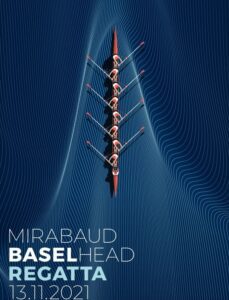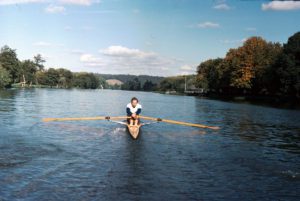Is there any simple exercise that can be employed to create better stability in a mens 4 coxed crew that have limited time with each other as a crew?
I have asked them to adjust their hand heights, but this hasn’t worked. There appears to be different motivation levels in the boat – would this affect the balance?
Rowing balance drills and exercises
Try a series of drills in your warm up every outing that help balance and teach consistent movement.
1. Row with oars on the surface of the water on the recovery. Then progress to a 1 centimetre tap down at the finish. Is the boat still balanced? If yes then do 2 cms, 3 etc.
Any time you lose balance go back a step to 2cms or 1cm tap down. Get the balance back then 10 strokes later advance to the next stage.
Try this all 4 rowing at half pressure then as you warm up do it firm pressure at low rate.
2. Challenge the crew to get the balance back (using accurate hand heights on the recovery) within 5 strokes of a wobble. Then try to reduce this to 4 strokes unbalanced before it recovers. 3, 2 and one stroke to balance.
The first drill teaches correct hand heights. The second raises awareness and skill at regaining the correct hand heights.
3. Lastly try rowing firm pressure at low rate with wide grip. Inside hand on the fat part of the shaft below the handle. This checks if the outside hand is doing the height control of the oar, especially tap down at the finish and also keeping the handle at a consistent level during the recovery.
Try combining 3 with 1 or 2 above to keep challenging the crew.
You may also find Jim Flood’s book “Balance” helpful – it’s a free download – share it with the crew and get them to discuss among themselves the causes of their boat imbalance. This can help them get buy in to solving the problem rather than relying on the coach (you) to supply all the answers.
Read more exercises and drills for rowing in the Rowperfect blog








This Post Has 5 Comments
I do not know about motivation levels. Each rower should endeavour to make perfect strokes each stroke. If you are adjusting hand heights, there is something else wrong. This is what I do:
I emphasize to the rowers that rowing is a binary sport. The oar is either buried in the water or it is a constant height out of the water. The hands are either high or low. The feet are either pressing against the foot stretcher or are not pressing against the foot stretcher (pulling against the foot stretcher).
Start with half the boat. Have the rowers pull into the release (all the way into the bow). Hands should be high, the blade buried and feet pressing against the foot stretcher. This establishes the first of two hand heights, blade depths, and foot pressures. (If the hand height is not acceptable for the rower, shim the oar in the oar lock up or down until it is correct for the rower). Now have the rowers push down on the oar handle to bring the oar blade clear of the water and feather. The outside hand has to keep downward pressure on the oar handle to keep the oar a constant height above the water. Now, hands away, body rock forward, and pull the body forward on the recovery. This establishes the second position, hands low, oar clear of the water, and pressure off the foot stretcher. The body should travel in a straight line with no deviation from the center line of the boat. With constant hand height and blade height, pull forward on the recovery into the catch where the rowers will be at the stern most position.. At the catch position with weight still off the foot stretcher, take the downward pressure off the hands. The design of the oars and oar lock and gravity cause the oar to drop into the water to the proper depth. (The rower should not lift their hands or shoulders. This creates instability). Now apply foot pressure to the foot stretcher and push the body into the bow with the blade buried and with constant hand height and the body moving in a straight line.. This completes one stroke.
Notice that in this cycle, the hands have been at only two discrete heights, the blades have been at two discrete positions in or out of the water, and the rower has either been pressing against the foot stretcher or has had their weight off the foot stretch (or has been pulling on it) and has had their body centered in the boat and traveled in a straight line
If the rowers visualize this properly, and execute their visualization well, the boat will be stable. If not, there is a breakdown in proper execution of maintaining the binary aspect of hand height, blade depth, and foot pressure. The cox in an eight, bow in a four, or coach in the launch can observe what is going on. An oar may be skying or dragging on the water on the recovery. Or the oar may be digging in or washing out on the stroke. Or if the rower’s body is not stable (no to and fro movement during the stroke or recovery) this will upset the boat.
This is what I call technical coxing (or coaching). Explain in technical terms what to do and also why this is the way to do it. Rowers I have instructed this way have picked up the ideas quickly. Sometimes, I stop the boat and have a pair work on and correct problems, and then resume practice. I have taken an eight just out of learn to row and had them rowing by all eight in that practice. By the same token, going through this with our first boat reinforced rowing technique and produced lower splits than before.
Of course, there are many other subtle details, but executing these fundamentals properly will probably get you an acceptably performing boat..
I am unable to download Jim Floods book ‘Balance’ is this still available as a free download
many thanks Jo
yes it’s here https://www.rowperfect.co.uk/product/balance-by-jim-flood-ebook-2/
listed as a free ebook – create an account in the shop and check out and then you can get out
Best wishes in rowing
Rebecca
Interesting stuff; fine for young rowers the same height and build but difficult when you get to a masters boat with “average” (tall, short, fat, thin, inflexible) rowers. A big problem is getting everyone the same distance out from the centreline of the boat at the same time thus maintaining a neutral platform. Is there anyway of setting foot stretcher position that will allow for different flexibilities and stroke lengths?
Roger, yes there is a way. If you are prepared to do individual rigs. So shoe height (higher or lower) and seat height (with or without a seat pad) can easily adjust the ability of an athlete to compress to shins vertical at the catch. This is not going to help rotation of the athlete but will go some way towards getting oars parallel at the blade entry. If you start by listening to the podcast I did with Tara Morgan at 40 minutes we talk specifically about getting to the catch for inflexible athletes. RowingChat with Tara Morgan rowing and aging